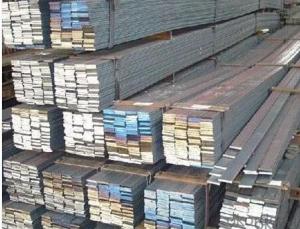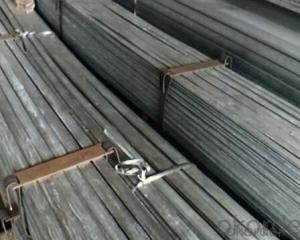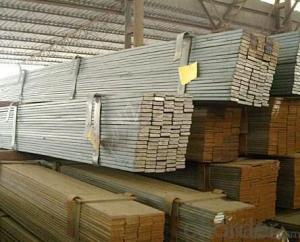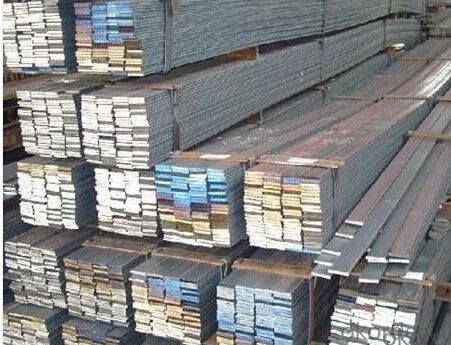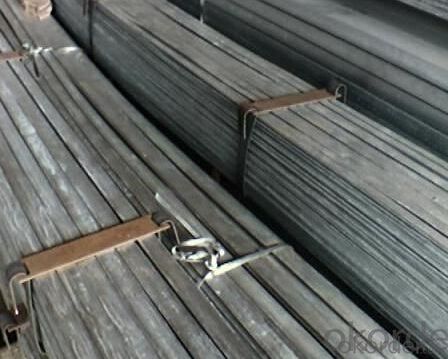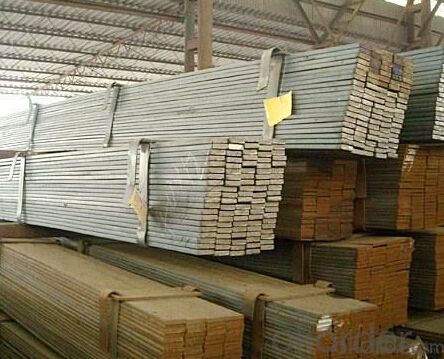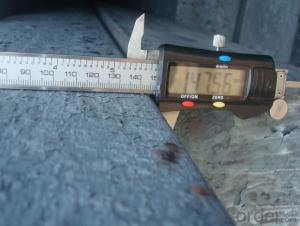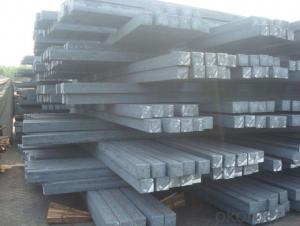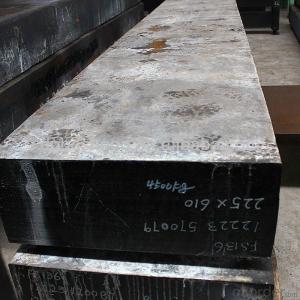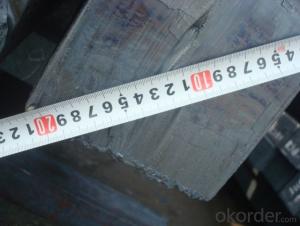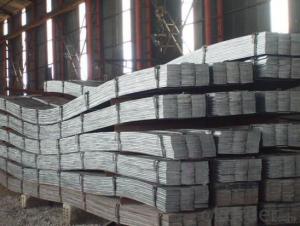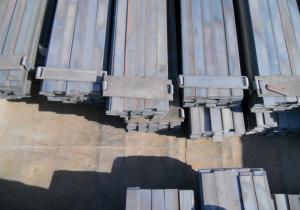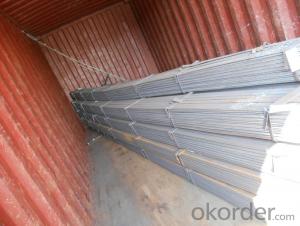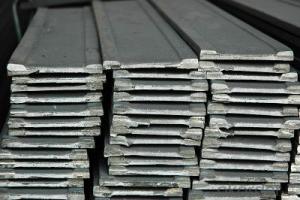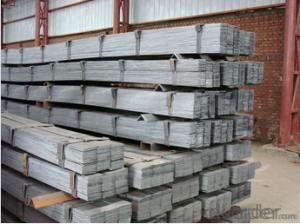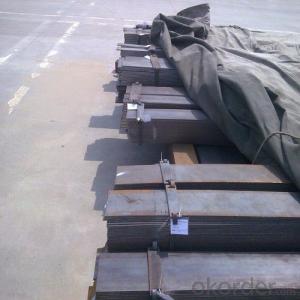Galvanized Flat Bar of Q235 with Leigth 6M/12M
- Loading Port:
- Tianjin
- Payment Terms:
- TT OR LC
- Min Order Qty:
- 50 m.t.
- Supply Capability:
- 1000 m.t./month
OKorder Service Pledge
OKorder Financial Service
You Might Also Like
Product Description:
OKorder is offering Galvanized Flat Bar of Q235 with Leigth 6M/12M at great prices with worldwide shipping. Our supplier is a world-class manufacturer of steel, with our products utilized the world over. OKorder annually supplies products to European, North American and Asian markets. We provide quotations within 24 hours of receiving an inquiry and guarantee competitive prices.
Product Applications:
Galvanized Flat Bar of Q235 with Leigth 6M/12M are ideal for structural applications and are widely used in the construction of buildings and bridges, and the manufacturing, petrochemical, and transportation industries.
Product Advantages:
OKorder's Galvanized Flat Bar of Q235 with Leigth 6M/12M are durable, strong, and resist corrosion.
Main Product Features:
· Premium quality
· Prompt delivery & seaworthy packing (30 days after receiving deposit)
· Corrosion resistance
· Can be recycled and reused
· Mill test certification
· Professional Service
· Competitive pricing
Specifications of Galvanized Flat Bar of Q235 with Leigth 6M/12M
1. Invoicing on theoretical weight or actual weight as customer request
2. Length: 6m, 12m as following table
3. Sizes:
Galvanized Flat Bar Zinc Thickness:15-80μ
Grade: A36, SS400, Q235, Q195
Standard: ASTM, JIS, GB
Thickness:1.5mm-20mm
Width: 10mm-250mm
Width | Thickness | Width | Thickness | Width | Thickness |
(mm) | (mm) | (mm) | (mm) | (mm) | (mm) |
8 | 5-7 | 50 | 5-25 | 200 | 8-40 |
10 | 3-9 | 55 | 5-25 | 220 | 8-40 |
12 | 3-9 | 60 | 5-25 | 250 | 8-40 |
13 | 5-11 | 65 | 5-25 | 260 | 8-40 |
14 | 3-12 | 70 | 5-25 | 270 | 8-40 |
15 | 5-12 | 75 | 5-25 | 280 | 8-40 |
16 | 4-14 | 80 | 6-25 | 290 | 8-40 |
18 | 4-16 | 85 | 6-25 | 300 | 8-40 |
20 | 4-18 | 90 | 6-25 | 310 | 8-40 |
22 | 4-20 | 95 | 6-25 | 320 | 8-40 |
24 | 5-20 | 100 | 6-25 | 330 | 8-40 |
25 | 4-20 | 105 | 6-25 | 340 | 8-40 |
28 | 4-20 | 110 | 6-25 | 350 | 8-40 |
30 | 4-25 | 120 | 7-25 | 360 | 8-40 |
32 | 4-25 | 125 | 7-25 | 370 | 8-40 |
35 | 4-25 | 130 | 8-25 | 380 | 8-40 |
36 | 6-25 | 140 | 8-25 | 390 | 8-40 |
38 | 7-25 | 150 | 8-25 | 400 | 8-40 |
40 | 4-25 | 160 | 8-40 | ||
45 | 4-25 | 180 | 8-40 |
5. Material Specifications:
Production Standard: GB/T 700-2006 | |||||
Grade | Chemical composition (%,max) | ||||
C | Si | Mn | P | S | |
Q195 | 0.12 | 0.30 | 0.50 | 0.035 | 0.040 |
Q235A | 0.22 | 0.35 | 1.40 | 0.045 | 0.050 |
Q235B | 0.20 | 0.35 | 1.40 | 0.045 | 0.045 |
Q235C | 0.17 | 0.35 | 1.40 | 0.040 | 0.040 |
Q235D | 0.17 | 0.35 | 1.40 | 0.035 | 0.035 |
Q235 is similar to ASTMA36,JIS SS400
Usage & Applications of Galvanized Flat Bar of Q235 with Leigth 6M/12M
Widely used for construction,Fabrication , Ship building, Machinery manufacturing, Steel structure
Packaging & Delivery of Galvanized Flat Bar of Q235 with Leigth 6M/12M
1. Packing: it is nude packed in bundles by steel wire rod
2. Bundle weight: not more than 3.5MT for bulk vessel; less than 3 MT for container load
3. Marks:
Color marking: There will be color marking on both end of the bundle for the cargo delivered by bulk vessel. That makes it easily to distinguish at the destination port.
Tag mark: there will be tag mark tied up on the bundles. The information usually including supplier logo and name, product name, made inChina, shipping marks and other information request by the customer.
If loading by container the marking is not needed, but we will prepare it as customer request.
4. Transportation: the goods are delivered by truck from mill to loading port, the maximum quantity can be loaded is around 40MTs by each truck. If the order quantity cannot reach the full truck loaded, the transportation cost per ton will be little higher than full load.
5. Delivered by container or bulk vessel
Production flow of Galvanized Flat Bar of Q235 with Leigth 6M/12M
The process of hot-dip galvanizing results in a metallurgical bond between zinc and steel with a series of distinct iron-zinc alloys. The resulting coated steel can be used in much the same way as uncoated.
A typical hot-dip galvanizing line operates as follows:
Steel is cleaned using a caustic solution. This removes oil/grease, dirt, and paint.
The caustic cleaning solution is rinsed off.
The steel is pickled in an acidic solution to remove mill scale.
The pickling solution is rinsed off.
A flux, often zinc ammonium chloride is applied to the steel to inhibit oxidation of the cleaned surface upon exposure to air. The flux is allowed to dry on the steel and aids in the process of the liquid zinc wetting and adhering to the steel.
The steel is dipped into the molten zinc bath and held there until the temperature of the steel equilibrates with that of the bath.
The steel is cooled in a quench tank to reduce its temperature and inhibit undesirable reactions of the newly formed coating with the atmosphere.
FAQ:
Q1: Why buy Materials & Equipment from OKorder.com?
A1: All products offered byOKorder.com are carefully selected from China's most reliable manufacturing enterprises. Through its ISO certifications, OKorder.com adheres to the highest standards and a commitment to supply chain safety and customer satisfaction.
Q2: How do we guarantee the quality of our products?
A2: We have established an advanced quality management system which conducts strict quality tests at every step, from raw materials to the final product. At the same time, we provide extensive follow-up service assurances as required.
Q3: How soon can we receive the product after purchase?
A3: Within three days of placing an order, we will begin production. The specific shipping date is dependent upon international and government factors, but is typically 7 to 10 workdays.
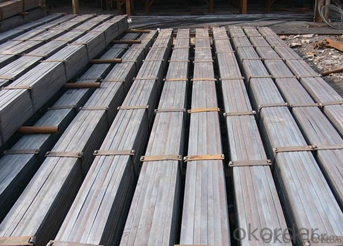
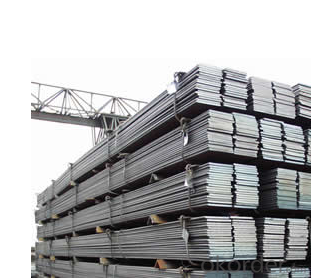
- Q: Are there any alternative materials to steel billets in certain applications?
- There exist several alternative materials to steel billets in certain applications, encompassing the following: 1. Aluminum: Exhibiting a lightweight nature and resistance to corrosion, aluminum serves as a prevalent substitute for steel in situations where reducing weight holds significance, particularly in the aerospace industry. 2. Copper: Possessing ductility and high conductivity, copper frequently finds usage in electrical and plumbing applications, offering an alternative to steel billets when elevated electrical conductivity becomes necessary. 3. Titanium: As a lightweight and robust material, titanium commonly serves in scenarios requiring both strength and resistance to corrosion, notably in the automotive and aerospace industries. 4. Composite materials: Carbon fiber reinforced polymers and similar composite materials increasingly serve as alternatives to steel in critical applications where weight reduction and high strength prove imperative, such as aircraft construction and high-performance sports equipment. 5. Plastic: For applications not demanding substantial strength or durability, plastic can substitute steel billets. Plastic showcases a lightweight quality, cost-effectiveness, and ease of molding into diverse shapes. When selecting an alternative material to steel billets, it remains crucial to consider the specific requirements of each application, as each material possesses its distinct properties and limitations.
- Q: Can steel billets be used for marine applications?
- Yes, steel billets can be used for marine applications. Steel billets are often used as a raw material for various marine components and structures. Due to their high strength and durability, steel billets are well-suited for marine applications that require resistance to corrosion, impact, and harsh environmental conditions. They can be used to manufacture ship hulls, propeller shafts, marine pipelines, offshore platforms, and other marine structures. Additionally, steel billets can be further processed and shaped into desired forms to meet specific requirements for marine applications.
- Q: What are the applications of steel billets in the automotive industry?
- Steel billets are an essential component in the automotive industry, playing a crucial role in various applications. One of the primary uses of steel billets in this industry is for the production of engine parts. The billets are forged and machined to create crankshafts, connecting rods, and camshafts, which are vital components for the proper functioning of an engine. Steel billets are also used in the manufacturing of suspension and steering components. These billets are shaped into various parts such as control arms, tie rods, and steering knuckles, which provide stability, control, and smooth handling to the vehicle. These components are crucial for ensuring a safe and comfortable driving experience. Furthermore, steel billets find applications in the production of transmission components. They are forged and machined to create gears, shafts, and other transmission parts that facilitate the smooth transfer of power from the engine to the wheels. These components play a significant role in the overall performance and efficiency of the vehicle. Additionally, steel billets are used in the manufacturing of chassis and frame components. By using billets, manufacturers can create strong and durable structures that provide stability and support to the entire vehicle. Chassis components such as cross members, brackets, and reinforcements are often made from steel billets to ensure the vehicle's structural integrity. In summary, steel billets are widely employed in the automotive industry for various applications. They are used to create engine parts, suspension and steering components, transmission parts, and chassis components. The use of steel billets in these applications ensures the durability, performance, and safety of vehicles.
- Q: What are the different forming processes used for steel billets?
- The different forming processes used for steel billets include hot rolling, cold rolling, extrusion, forging, and casting.
- Q: How are steel billets tested for strength and durability?
- Steel billets are tested for strength and durability through various methods such as tensile testing, hardness testing, impact testing, and microstructure examination. These tests help determine the strength, ductility, and resistance to deformation and fracture of the steel billets, ensuring their suitability for various applications.
- Q: Can steel billets be used for making architectural structures?
- Yes, steel billets can be used for making architectural structures. Steel billets are semi-finished products that are typically cast into specific shapes and sizes before being further processed into different steel products. These billets can be used as a raw material for fabricating various architectural structures such as beams, columns, frames, and trusses. Steel is a widely used material in the construction industry due to its high strength, durability, and versatility. It offers several advantages over other construction materials, including its ability to withstand heavy loads, resist corrosion, and provide excellent fire resistance. Steel billets can be processed and shaped into different forms, allowing architects and engineers to create innovative and complex architectural designs. Furthermore, steel structures offer several benefits in terms of cost-effectiveness, speed of construction, and sustainability. Steel is a highly recyclable material, making it an environmentally friendly choice. The use of steel billets in architectural structures enables the construction of large and complex structures with greater precision and efficiency. Overall, steel billets can be effectively used in the construction of architectural structures, offering numerous advantages in terms of strength, durability, design flexibility, and sustainability.
- Q: How do steel billets contribute to the chemical industry?
- Steel billets are a crucial raw material in the chemical industry as they are used in the production of various chemical equipment and machinery. These billets serve as a foundation for manufacturing components such as pipes, valves, tanks, and reactors, which are essential in carrying out chemical processes. Their strength, durability, and resistance to high temperatures make steel billets an ideal choice for constructing reliable and safe equipment used in the chemical industry.
- Q: What are the main factors affecting the weldability of steel billets?
- The main factors affecting the weldability of steel billets include the composition of the steel, the presence of impurities, the presence of alloying elements, the size and shape of the billets, and the heat treatment of the steel.
- Q: How are steel billets used in the manufacturing of electrical equipment?
- Steel billets are used in the manufacturing of electrical equipment in various ways. One of the main applications is in the production of electrical transformers. Transformers are crucial components in electrical systems as they transfer electrical energy between different voltage levels. Steel billets are used to manufacture the core of transformers, which is responsible for efficiently transferring the electrical energy. The steel billets are first heated and then rolled into thin strips or sheets, which are then cut into specific shapes and sizes to form the core laminations. These laminations are stacked together and insulated to minimize energy losses and ensure efficient power transfer. The use of steel billets ensures the core's strength, durability, and magnetic properties, which are essential for the transformer's functionality. Steel billets are also utilized in the manufacturing of other electrical equipment such as motors and generators. In these applications, the billets are formed and machined into specific components, such as rotor and stator cores, that play a vital role in the generation and conversion of electrical energy. Moreover, steel billets are used in the production of electrical enclosures and cabinets, which protect sensitive equipment and wiring from external factors like moisture, dust, and physical damage. These billets are shaped, welded, and assembled to create sturdy and reliable enclosures that house electrical components. Overall, steel billets are an integral part of the manufacturing process for electrical equipment. Their versatility, strength, and magnetic properties make them suitable for various applications, ensuring the efficiency, reliability, and longevity of electrical systems.
- Q: What are the advantages of using steel billets in manufacturing?
- There are several advantages of using steel billets in manufacturing. Firstly, steel billets are highly versatile and can be easily shaped into various forms, making them suitable for a wide range of applications. Secondly, steel billets have excellent strength and durability, ensuring the final products made from them are strong and long-lasting. Additionally, steel billets have good resistance to corrosion and can withstand high temperatures, making them ideal for use in harsh environments. Lastly, steel billets are readily available and cost-effective, making them a preferred choice for many manufacturers.
Send your message to us
Galvanized Flat Bar of Q235 with Leigth 6M/12M
- Loading Port:
- Tianjin
- Payment Terms:
- TT OR LC
- Min Order Qty:
- 50 m.t.
- Supply Capability:
- 1000 m.t./month
OKorder Service Pledge
OKorder Financial Service
Similar products
Hot products
Hot Searches
Related keywords
